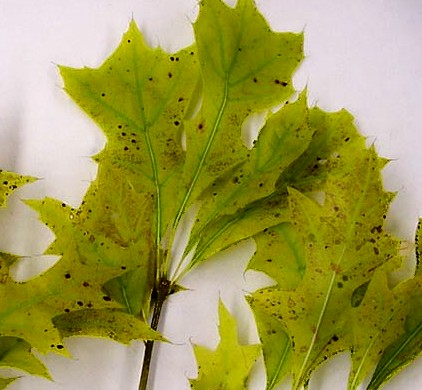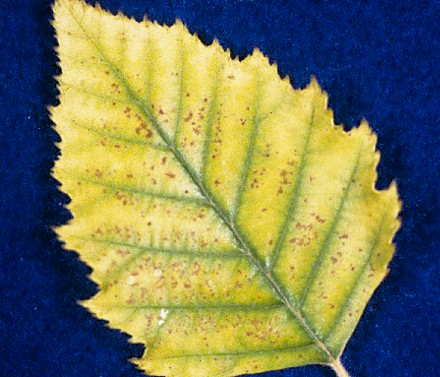Chlorosis in Oak, River Birch and Maple

The most common micronutrient deficiencies seen in landscape plants in Nebraska are iron deficiency of pin oak, river birch, and maple trees. Manganese deficiency of maples and birch. Both deficiencies are marked by pale green or yellow leaves, with veins that remain green. When a tree is deficient, new growth is stunted, branches may die back, and the margins and interveinal areas of leaves may become brown. In severe cases, the entire tree may decline over several years and die.

During the summer of 2009, we had an increased amount of chlorosis in River Birch. Several of these trees were dying from the deficiency. The iron products we had been using were not working as effectively, so we decided to look deeper into the problem. We determined soil compaction, lack of oxygen, and the micronutrients were tied up in alkaline soil. After several trials with different micronutrients and the use of an aeration process which we used on Pin Oaks in the past, we were able to establish a two phase program. First, we began using a product with a combination of Iron, Zinc and Manganese. The second part was to aerate the soil and change the conditions of that caused the decline of the tree. The aeration process increased drainage and increased oxygen supply in the soil.
We are still evaluating our results, but I feel that we have found a longer term solution for chlorosis in River Birch, Pin Oak, and Silver Maple.

The most common micronutrient deficiencies seen in landscape plants in Nebraska are iron deficiency of pin oak, river birch, and maple trees. Manganese deficiency of maples and birch. Both deficiencies are marked by pale green or yellow leaves, with veins that remain green. When a tree is deficient, new growth is stunted, branches may die back, and the margins and interveinal areas of leaves may become brown. In severe cases, the entire tree may decline over several years and die.

During the summer of 2009, we had an increased amount of chlorosis in River Birch. Several of these trees were dying from the deficiency. The iron products we had been using were not working as effectively, so we decided to look deeper into the problem. We determined soil compaction, lack of oxygen, and the micronutrients were tied up in alkaline soil. After several trials with different micronutrients and the use of an aeration process which we used on Pin Oaks in the past, we were able to establish a two phase program. First, we began using a product with a combination of Iron, Zinc and Manganese. The second part was to aerate the soil and change the conditions of that caused the decline of the tree. The aeration process increased drainage and increased oxygen supply in the soil.
We are still evaluating our results, but I feel that we have found a longer term solution for chlorosis in River Birch, Pin Oak, and Silver Maple.
Diseases | Insect Pests | Emerald Ash Borer 2015